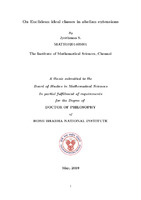- DSpace Home
- →
- IMSc Theses/ Dissertations
- →
- IMSc Theses/ Dissertations
- →
- View Item
JavaScript is disabled for your browser. Some features of this site may not work without it.
| dc.contributor.author | Jyothsnaa, S. | |
| dc.date.accessioned | 2019-07-01T07:56:11Z | |
| dc.date.available | 2019-07-01T07:56:11Z | |
| dc.date.issued | 2019 | |
| dc.date.submitted | 2019 | |
| dc.identifier.uri | https://dspace.imsc.res.in/xmlui/handle/123456789/440 | |
| dc.description.abstract | The study of growth and distribution of class numbers of number fields constitutes a venerable theme in number theory. The origin of this theory can be traced to Gauss’s Disquisitiones Arithmeticae. One is immediately led to the following questions (and meta questions) listed presumably in decreasing order of difficulty: • Are there infinitely many real quadratic number fields with class number 1? • Whether the distribution of class numbers/p-torsion elements in class groups is more uniform among the lower degree number fields, say among quadratic and cubic fields? • Whether the ring of integers of number fields with class number 1 are “generic” or “special”? In this thesis we will introduce an open problem pertaining to the last question, witness its extension to the second question and finally state our results in this context. The first question of course still remains far from our reach. As we shall see, these seemingly algebraic questions force or lead us to deep arithmetic and analytic issues which are intricately linked to the distribution of prime ideals in number fields. Hence, they naturally lead us to the Holy Grail: the Riemann hypothesis, not just over rationals, but over number fields. | en_US |
| dc.publisher.publisher | The Institute of Mathematical Sciences | |
| dc.title | On Euclidean ideal classes in abelian extensions[HBNI Th152] | en_US |
| dc.type.degree | Ph.D | en_US |
| dc.type.institution | HBNI | en_US |
| dc.description.advisor | Sanoli Gun | |
| dc.description.pages | 136P. | en_US |
| dc.type.mainsub | Mathematics | en_US |
| dc.type.hbnibos | Mathematical Sciences |
Files in this item
This item appears in the following Collection(s)
-
IMSc Theses/ Dissertations
IMSc Theses/ Dissertations
